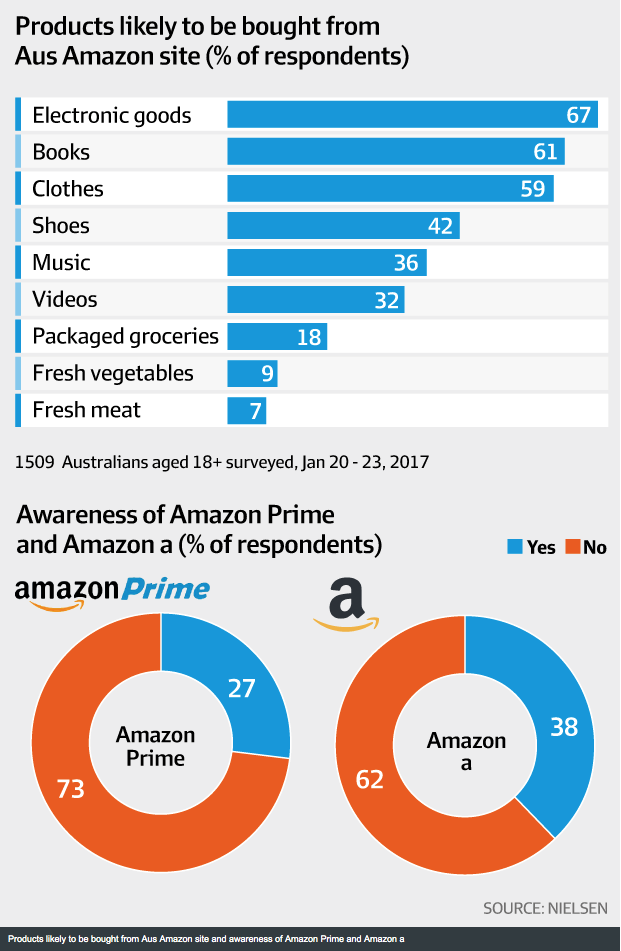Amazon could be moving to Australia
February 19, 2017
AFR
Three out of four (75 per cent) of Australians aged over 18 say they are interested in Amazon Australia and 56 per cent are likely to purchase from its Australian site, according to a Nielsen survey conducted last month.New research has underlined the threat to retailers from online juggernaut Amazon, which is expected to ramp up its presence in Australia later this year.
About 45 per cent say they would subscribe to Amazon Prime to receive special deals, discounts and faster delivery.
The categories likely to be most affected by Amazon’s expansion are electronic goods, books, clothing and shoes.

About 67 per cent of respondents said they were likely to buy electronics from an Amazon Australia site, 61 per cent books, 59 per cent clothing and 42 per cent footwear.
However, the survey suggested low levels of interest in Amazon Fresh, an online and bricks and mortar food and grocery service, with only 9 per cent of respondents saying they were likely to buy fresh vegetables and 7 per cent saying they would buy fresh meat from Amazon Australia.
This compares with 6 per cent of Australian households who bought groceries online in December.
Nielsen’s research also showed Amazon already has a high level of engagement with Australian shoppers.
While conversion rates for most Australian online retailers are low, less than 10 per cent, Nielsen Omnibus research showed that Amazon’s US site converts almost one in two Australian shoppers (49 per cent) into sales.
This is the fourth highest behind eBay (78 per cent), Amazon’s The Book Depository (74 per cent) and Australian online fashion retailer The Iconic (53 per cent).
Australian consumers spend between $500 million and $700 million a year on Amazon sites, less than they do at Woolworths’ or Wesfarmers’ online stores.
Citigroup’s head of research, Craig Woolford, believes Amazon could capture sales of at least $4 billion within five years of rolling out its services, representing 14 per cent of all online spending and 1.1 per cent of total retail spending.
Citigroup believes retailers who will be most exposed include JB Hi-Fi and Harvey Norman, specialty retailers such as Super Retail Group and Premier Investments, department stores (Myer, Target, and BIG W) and footwear retailers such as RCG.
“We expect the greatest impact to be felt by electronics retailers given Amazon’s product range and the branded nature of these products,” Mr Woolford said in a recent report. “We estimate 44 per cent of its product sales would be electronics [and] the next largest category is likely to be physical and electronic media including books.”
Profits could fall around 20 per cent as sales shift to Amazon, triggering negative operating leverage, and gross margins come under pressure as prices fall. Amazon is reportedly planning to undercut local prices by as much as 30 per cent.
Some retailers, such as Woolworths, Wesfarmers, Myer and JB Hi-Fi, have been preparing for Amazon’s arrival for months if not years, setting up dedicated units to respond to the Amazon threat, building omni-channel capabilities and customer databases and improving in-store services and experiences.
However, experts fear many retailers are woefully under-prepared and the volume of retailers slipping into administration will increase.
Ferrier Hodgson retail partner James Stewart says Amazon now sells more clothing online than all other online retailers in the US. As a result, there is a “small tsunami” of retailers filing for Chapter 11 bankruptcy protection.
“When Amazon comes to Australia, whether it’s this year or not, it will take a year or two to have that knock-on effect,” Mr Stewart said.
Amazon insiders claim the company will roll out Amazon Prime Now in 2017, gradually increase the number of items and launch Amazon Fresh six to eight months later, initially importing food from an Amazon facility in Singapore before signing agreements with local suppliers and leasing its own warehouses. Amazon Fresh bricks and mortar stores would follow in 2018.
However, Mr Woolford believes Amazon is unlikely to establish a full physical presence in Australia for another two years, citing the need to set up fulfilment centres and sorting centres and to secure Australian brands.
Subscribe to our free mailing list and always be the first to receive the latest news and updates.
